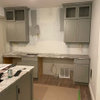This is a partial X-post from Plumbing but this forum moves faster than any and I need an answer "yesterday", so I am asking for your indulgence. Plus, I learned about recirc pumps on this board. :-)
Our water heater is installed far away from the main point of use and it takes *forever* to get hot water in the kitchen and MB. After learning about recirc pump on this forum, I had no doubt I wanted one. But my plumber says the house is not set up for a recirculating pump and there is only one kind that can be retrofitted, which would run me ~$1K to install.
If I decide I could live with running water for several minutes ever time I need it hot, is the upfront cost worth it compared to saving on water usage?
Anything else I need to consider?
Yes, I know about water conservation and I do want to be "green" but I have spent about twice of what I had planned on the kitchen remodel, so I'm hard-pressed for cash. :-( Plus, I can use that running water for items that require hand-washing.
WWYD?
Thank you!











GauchoGordo1993
Clarion
Related Professionals
Wood River Kitchen & Bathroom Remodelers · Blasdell Kitchen & Bathroom Remodelers · Channahon Kitchen & Bathroom Remodelers · Chester Kitchen & Bathroom Remodelers · Gardner Kitchen & Bathroom Remodelers · Glen Carbon Kitchen & Bathroom Remodelers · Kettering Kitchen & Bathroom Remodelers · Park Ridge Kitchen & Bathroom Remodelers · Schiller Park Kitchen & Bathroom Remodelers · Sioux Falls Kitchen & Bathroom Remodelers · Warren Kitchen & Bathroom Remodelers · Salisbury Cabinets & Cabinetry · Wildomar Cabinets & Cabinetry · Santa Rosa Tile and Stone Contractors · Bloomingdale Design-Build Firmsgwlolo
sushipup1
jillies01
User
eleenaOriginal Author
a2gemini
GauchoGordo1993
debrak2008
angela12345
GreenHighlighter
GauchoGordo1993
Annie Deighnaugh
User